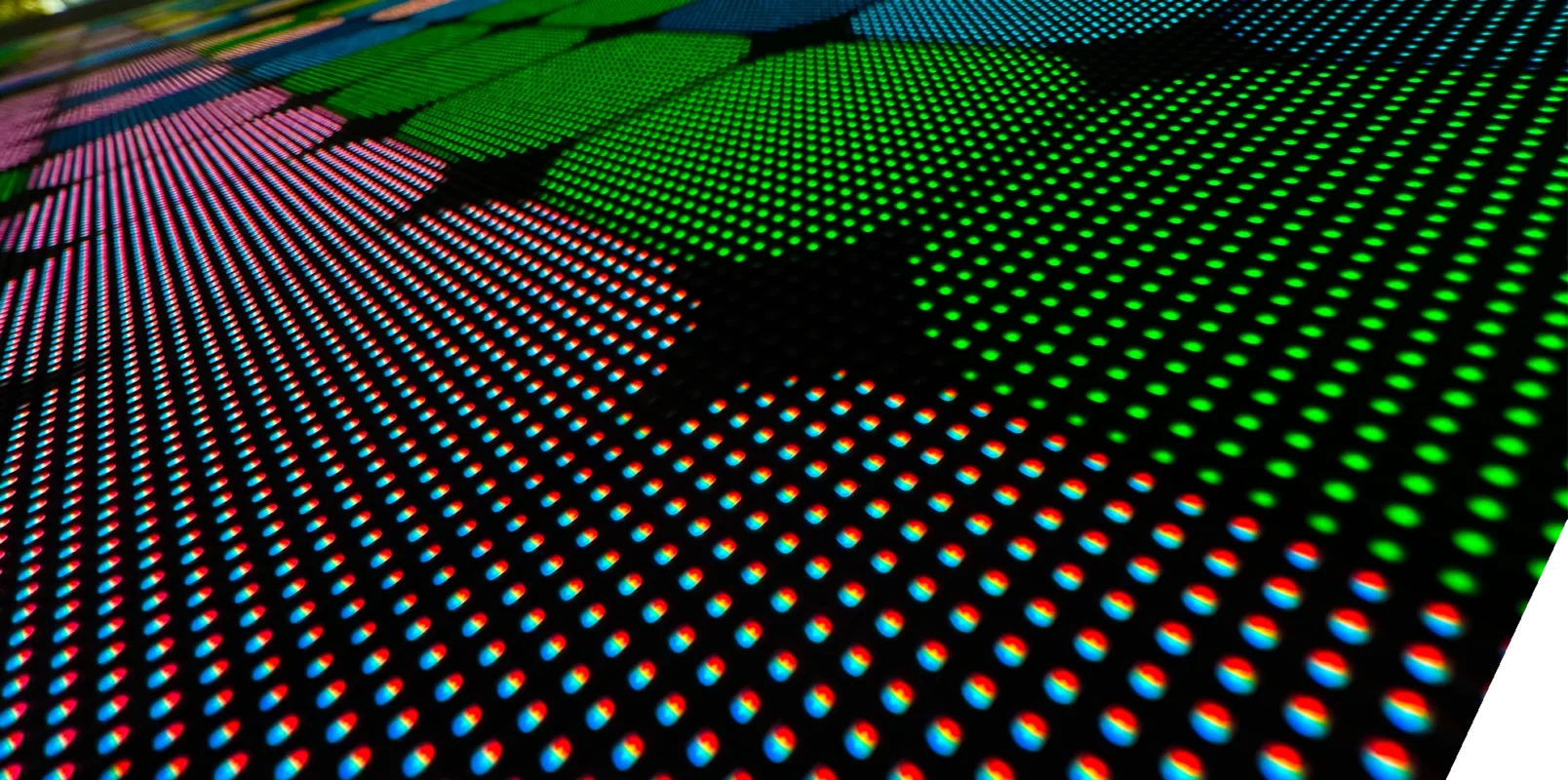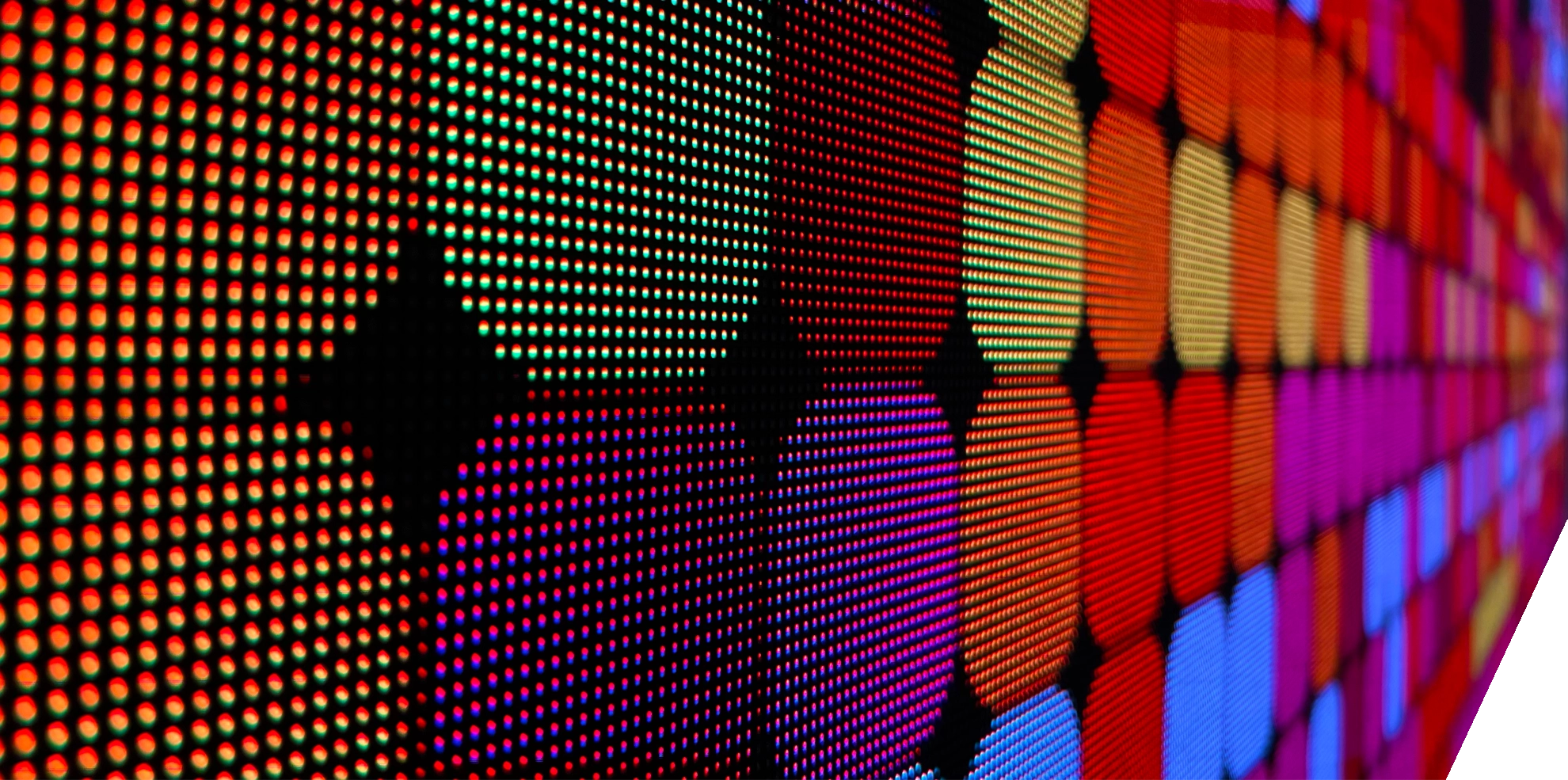The magic of LED Wall technologies – an overview
13.06.2025
Join us as we dive into the fascinating world of LED technologies that are revolutionising our visual experiences. Whether indoors or outdoors, the right LED technology is crucial for successfully transforming any environment into an impressive visual space. From the brilliant colour accuracy of indoor MicroLEDs to the robust durability of DIP LEDs for outdoor use, each technology has its own unique strengths. Discover how these technologies are redefining the limits of content and advertising in our public spaces and what role pixel pitch plays in this. In this article, we present the most important LED technologies for video walls and discuss what to look for when buying your own solution.
Indoors vs. outdoors
The right LED wall technology for impressive visual experiences
In the world of LED video wall technologies, there are clear differences between solutions for indoor and outdoor use. SMD LEDs (surface-mounted devices) are the undisputed favourite for indoor applications. With their ability to deliver brilliant colours, high image sharpness and extremely small pixel pitches, they are perfect for high-resolution, detailed content. The wide viewing angle ensures that audiences can enjoy the content from different perspectives. However, this technology comes at a price: SMD LEDs are relatively expensive to purchase and require careful installation and maintenance.

In contrast, DIP (Dual In-Line Package) LEDs are the robust choice for outdoor use. Their resistance to environmental influences and high brightness make them ideal for outdoor use, even in direct sunlight. However, they cannot quite match SMD LEDs in terms of image quality and colour fidelity. The larger pixel pitch makes them more suitable for large-scale installations where viewers are further away.
Pixel pitch
Best image quality at any distance
In the world of LED video walls, “pixel pitch“ plays a crucial role in determining image quality. This term describes the distance between the centres of adjacent pixels and has a significant impact on the picture resolution of a video wall. Choosing the right pixel pitch is essential to ensure that the display is optimally suited to the environment and viewing distance.
A smaller pixel pitch ensures sharper and more detailed images, which are particularly suitable for installations where the viewer is close to the LED wall. Typical pixel pitch sizes for indoor screens are between 0,7mm – 5mm. This fine resolution is ideal for indoor spaces or locations where viewers experience the content at close range. Larger pixel pitches, on the other hand, are perfect for expansive outdoor installations where viewers are farther away. Typical pixel pitches for outdoor screens are between 5-20mm. Considering the viewing distance is crucial to achieving the maximum impact of a video wall. Whether for an intimate gallery or a sprawling stadium, the right pixel pitch makes all the difference and ensures that content is always presented in the best quality.
Transparent mesh screens
Mesh screens are typically semi-transparent with a pixel pitch of between 8-60mm. The lower the pixel pitch the more light can fall through the screen increasing the transparency. The level of transparency will change for a mesh screen depending on the pixel pitch. A screen with a 8mm pixel pitch would typically have a transparency of approximately 50%. In some cases the pixel pitch is non-symetrical, meaning the pixel pitch in the vertical can be different to that in the horizontal. In this case 10mm in the vertical and 28mm in the horizontal could be possible configuration.
Brightness
The importance of the right brightness
The brightness or luminosity of an LED wall is a decisive factor in its performance and is measured in candelas or nits. One nit represents one candela per square meter (cd/m²). Outdoor LED walls in particular must achieve high brightness values so that content remains clear and visible even in direct sunlight. Typical values for outdoor LED walls are between maximum 6000-8000 cd/m². Indoor screens on the other hand will be less bright. Maximum values between 500-1500 cd/m² are more common. But it’s not just about maximum luminosity; a balance between brightness and energy efficiency is equally important to avoid unnecessary energy consumption and protect the environment.
Modern LED walls have a clever trick up their sleeve: the auto-dimming function. This smart technology automatically adjusts the brightness of the LED wall to match ambient light conditions, ensuring that visibility remains consistently good. At the same time, energy efficiency is improved, which not only reduces power consumption but also extends the service life of the LEDs. Auto-dimming makes LED walls not only smarter but also more sustainable and cost-efficient – a real win for any application. An outdoor LED wall will be typically dimmed to about 5% of its maximum brightness at nighttime to ensure the screen does not appear too bright in relation to its environment.
MicroLED
The future of display technology
MicroLED technology is at the dawn of a revolutionary change in the world of displays. With its ability to offer extremely high resolutions combined with impressive energy efficiency and exceptional durability, it promises a huge leap forward in innovation. The image quality of MicroLEDs impresses with high brightness and excellent colour accuracy, making them the ideal choice for demanding visual experiences.
Currently, microLEDs are mainly suitable for high-end installations in the premium segment due to their complex manufacturing and high costs. A microLED pixel can be as small as 5 μm across but the majority of present manufacturers tend to use the term microLED if the pixel pitch is less than 3mm, as in the case of Samsung’s “The Wall” product. The technology is gaining ground and will play an increasingly important role in the future. With its outstanding properties, it could fundamentally change the way we experience and use screens.
Flip-Chip-LED
High brightness applications
In the world of LED technologies, flip-chip LEDs are proving to be the optimum solution for applications that require high brightness. Their optimised thermal management, in which the chip is mounted directly on the substrate, enables efficient heat dissipation. This feature extends the service life of the LEDs and ensures consistent performance.
Thanks to their higher performance and brightness, flip-chip LEDs are ideal for demanding projects that require intense light sources. However, this technology comes with higher manufacturing costs, making it more expensive and technically challenging. Despite these challenges, flip-chip LEDs offer an impressive solution for those looking for exceptional light performance.
COB-Technologie
The compact power solution for uniform illumination
COB (chip on board) technology is revolutionising the way LED screens are designed. Mounting multiple LED chips directly onto a circuit board creates a compact design with impressive light density and particularly even illumination. This technology not only offers efficient use of space, but also outstanding light quality that is ideal for many applications.
COB LEDs are known for their energy efficiency and longevity, making them a sustainable choice. However, to realise the full potential of this technology, a sophisticated cooling system is required to prevent overheating. Compared to SMD LEDs, the pixel pitch customisation options are limited, making them less flexible for certain applications.
Despite these limitations, COB LEDs offer a compact and powerful solution for those looking for uniform and efficient illumination. Their innovative design and sustainable properties make them the perfect choice for many indoor installations.
Shader-Technologie
How protection from the elements can also improve the image
In the world of LED displays, shaders are an essential element that significantly improves performance and appearance. These components not only protect the sensitive LED pixels and internal components, but also increase image contrast, resulting in more vivid and sharper images.
LED shaders act as a protective shield for the sensitive LED pixels and other internal components. They protect the displays from environmental influences such as rain, wind, snow, moisture, dirt and dust.
By blocking ambient light, shaders also create a darker background against which the LED pixels can shine. This results in a higher contrast ratio, making images appear more vivid and clearer.
There are primarily two types of shaders: module shaders that fit individually around each pixel or slats that mask one or more sides of a pixel. Both enhance contrast. Glare is also reduced because less light spills from the display. In addition, the technology’s service life is extended as protection from the elements prevents damage.
Furthermore, shaders can be used to generate focused LED light immision through asymmetrically mounted shaders that can shield light so that the LED and screen can be seen or masked from one particular viewpoint.
Conclusion:
LED video walls offer a wide range of technologies that can be used to their advantage depending on the application and requirements. When planning an LED wall, questions about the environment, the desired image quality and the budget should be asked. Whether for high-resolution indoor installations or large-scale outdoor projects, choosing the right technology is crucial for the best optimum result and should therefore be carefully considered on an individual basis.



